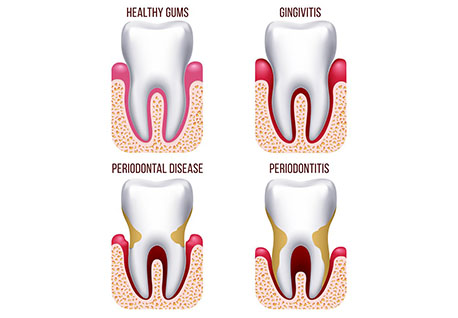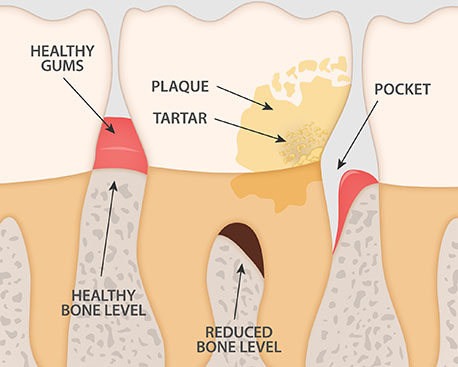Periodontal Disease
Periodontal diseases are infections of the gums and bone that surround and support the teeth. In its early stage, called gingivitis, the gums can become swollen and red, and they may bleed. In its more serious form, called periodontists, the gums can pull away from the tooth, bone can be lost, and the teeth may loosen or even fall out. Periodontal disease is mostly seen in adults. Periodontal disease and tooth decay are the two biggest threats to dental health.

Causes
Bacteria in the mouth infect tissue surrounding the tooth, causing inflammation around the tooth leading to periodontal disease. When bacteria stay on the teeth long enough, they form a film called plaque, which eventually hardens to tartar, also called calculus. Tartar build-up can spread below the gum line, which makes the teeth harder to clean. Then, only a dental health professional can remove the tartar and stop the periodontal disease process.

Warning signs
The following are warning signs of periodontal disease:
- Bad breath or bad taste that won’t go away
- Red or swollen gums
- Tender or bleeding gums
- Painful chewing
- Loose teeth
- Sensitive teeth
- Gums that have pulled away from your teeth
- Any change in the way your teeth fit together when you bite
- Any change in the fit of partial dentures
Cosmetic Dentures
Certain factors increase the risk of periodontal disease:
- Smoking
- Diabetes
- Poor oral hygiene
- Stress
- Heredity
- Crooked teeth
- Underlying immuno-deficiencies—e.g., AIDS
- Fillings that have become defective
- Taking medications that cause dry mouth
- Bridges that no longer fit properly
- Female hormonal changes, such as with pregnancy or the use of oral contraceptives
Prevention and treatment
Gingivitis can be controlled and treated with good oral hygiene and regular professional cleaning. More severe forms of periodontal disease can also be treated successfully but may require more extensive treatment. Such treatment might include a deep cleaning of the tooth-root surfaces below the gums, medications prescribed to take by mouth or placed directly under the gums, and sometimes corrective surgery.
To help prevent or control periodontal diseases,
it is important to:
- Brush and floss every day to remove the bacteria that cause gum disease.
- See a dentist at least once a year for checkups, or more frequently if you have any of the warning signs or risk factors mentioned above
PATIENT'S TESTIMONIALS

Dr. Manish Raj who showed lots of concern and did a wonderful root canal therapy and saved my tooth."The meticulous and patient approach and that kind of human touch are worth mentioning. He acts with confidence and hence is always successful."
Dr. Varsha Agarwal
Consultant Pathologist KNMH,Prayagraj
Before coming to SMILE DESIGNER DENTAL HOSPITAL, I was always apprehensive to visit a dentist, and the result was that I had a bad caries molar tooth. There seemed no option except the loss of tooth. It was then Dr. Manish Raj who showed lots of concern and did a wonderful root canal therapy and saved my tooth." The meticulous and patient approach and that kind of human touch are worth mentioning. He acts with confidence and hence is always successful."
Chaya.P.Mishra
Consultant Nutritionist, Prayagraj
when I visited Dr.Manish Raj but he made everything appear extremely easy and comforted me. Thank you 'Smile designers'Everyone was so friendly and helpful. The office was very professional, and they really took the time to make me feel comfortable and welcome. Their commitment to making sure I was 100% satisfied.."
Nuzra Mansoor Khan
Lucknow
